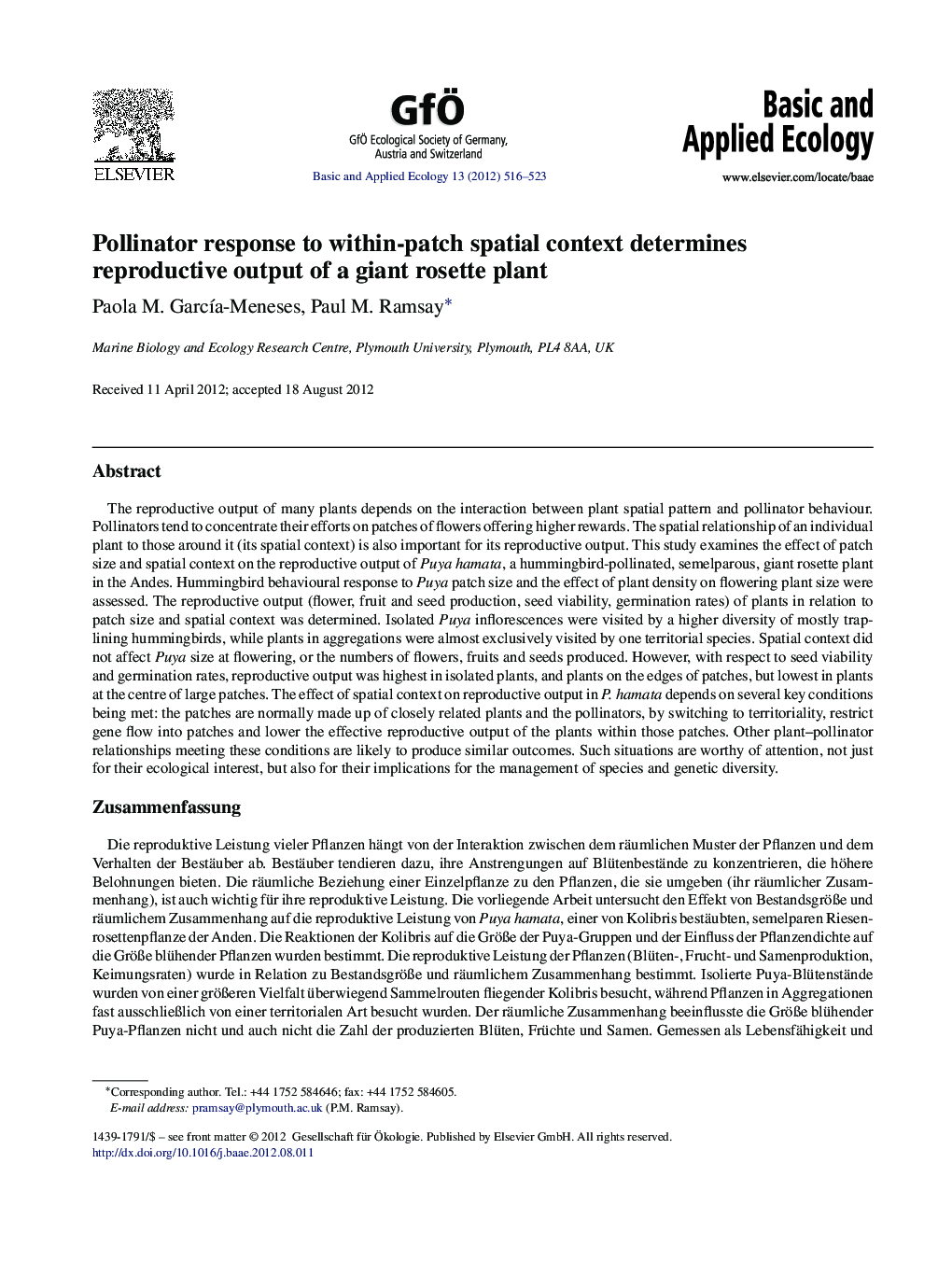| کد مقاله | کد نشریه | سال انتشار | مقاله انگلیسی | نسخه تمام متن |
|---|---|---|---|---|
| 4384045 | 1304385 | 2012 | 8 صفحه PDF | دانلود رایگان |

The reproductive output of many plants depends on the interaction between plant spatial pattern and pollinator behaviour. Pollinators tend to concentrate their efforts on patches of flowers offering higher rewards. The spatial relationship of an individual plant to those around it (its spatial context) is also important for its reproductive output. This study examines the effect of patch size and spatial context on the reproductive output of Puya hamata, a hummingbird-pollinated, semelparous, giant rosette plant in the Andes. Hummingbird behavioural response to Puya patch size and the effect of plant density on flowering plant size were assessed. The reproductive output (flower, fruit and seed production, seed viability, germination rates) of plants in relation to patch size and spatial context was determined. Isolated Puya inflorescences were visited by a higher diversity of mostly trap-lining hummingbirds, while plants in aggregations were almost exclusively visited by one territorial species. Spatial context did not affect Puya size at flowering, or the numbers of flowers, fruits and seeds produced. However, with respect to seed viability and germination rates, reproductive output was highest in isolated plants, and plants on the edges of patches, but lowest in plants at the centre of large patches. The effect of spatial context on reproductive output in P. hamata depends on several key conditions being met: the patches are normally made up of closely related plants and the pollinators, by switching to territoriality, restrict gene flow into patches and lower the effective reproductive output of the plants within those patches. Other plant–pollinator relationships meeting these conditions are likely to produce similar outcomes. Such situations are worthy of attention, not just for their ecological interest, but also for their implications for the management of species and genetic diversity.
ZusammenfassungDie reproduktive Leistung vieler Pflanzen hängt von der Interaktion zwischen dem räumlichen Muster der Pflanzen und dem Verhalten der Bestäuber ab. Bestäuber tendieren dazu, ihre Anstrengungen auf Blütenbestände zu konzentrieren, die höhere Belohnungen bieten. Die räumliche Beziehung einer Einzelpflanze zu den Pflanzen, die sie umgeben (ihr räumlicher Zusammenhang), ist auch wichtig für ihre reproduktive Leistung. Die vorliegende Arbeit untersucht den Effekt von Bestandsgröße und räumlichem Zusammenhang auf die reproduktive Leistung von Puya hamata, einer von Kolibris bestäubten, semelparen Riesenrosettenpflanze der Anden. Die Reaktionen der Kolibris auf die Größe der Puya-Gruppen und der Einfluss der Pflanzendichte auf die Größe blühender Pflanzen wurden bestimmt. Die reproduktive Leistung der Pflanzen (Blüten-, Frucht- und Samenproduktion, Keimungsraten) wurde in Relation zu Bestandsgröße und räumlichem Zusammenhang bestimmt. Isolierte Puya-Blütenstände wurden von einer größeren Vielfalt überwiegend Sammelrouten fliegender Kolibris besucht, während Pflanzen in Aggregationen fast ausschließlich von einer territorialen Art besucht wurden. Der räumliche Zusammenhang beeinflusste die Größe blühender Puya-Pflanzen nicht und auch nicht die Zahl der produzierten Blüten, Früchte und Samen. Gemessen als Lebensfähigkeit und Keimungsrate der Samen war indessen die reproduktive Leistung bei isoliert stehenden Pflanzen und Pflanzen am Bestandsrand am höchsten und am geringsten bei Pflanzen in der Mitte großer Bestände. Der Einfluss des räumlichen Zusammenhangs auf die reproduktive Leistung von Puya hamata hängt davon ab, dass verschiedene Schlüsselbedingungen erfüllt sind: Die Bestände bestehen normalerweise aus nahverwandten Pflanzen, und, indem die Bestäuber sich hier territorial verhalten, begrenzen sie den Genfluss in den Bestand hinein und verringern die reproduktive Leistung der Pflanzen innerhalb dieser Bestände. Andere Pflanze-Bestäuber-Beziehungen, die diese Bedingungen erfüllen, werden vermutlich zu ähnlichen Ergebnissen führen. Solche Konstellationen sind beachtenswert, nicht nur wegen ihres ökologischen Interesses, sondern auch wegen ihrer Weiterungen für das Artenmanagement und die genetische Vielfalt.
Journal: Basic and Applied Ecology - Volume 13, Issue 6, September 2012, Pages 516–523